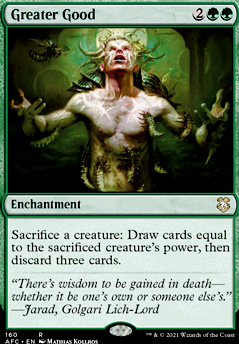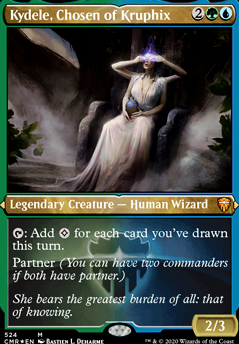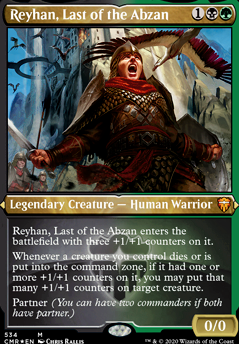Enhancer (45)
- 1x Astral Cornucopia
- 1x Attrition
- 1x Bioshift
- 1x Bloodspore Thrinax
- 1x Bone Splinters
- 1x Champion of Lambholt
- 1x Chasm Skulker
- 1x Corpsejack Menace
- 1x Crystalline Crawler
- 1x Deepglow Skate
- 1x Disciple of Bolas
- 1x Fathom Mage
- 1x Forgotten Ancient
- 1x Genesis Hydra
- 1x Glen Elendra Archmage
- 1x Greater Good
- 1x Gyre Sage
- 1x Hangarback Walker
- 1x Hooded Hydra
- 1x Inspiring Call
- 1x Kalonian Hydra
- 1x Kiora's Follower
- 1x Krav, the Unredeemed
- 1x Kruphix, God of Horizons
- 1x Lifeblood Hydra
- 1x Life's Legacy
- 1x Managorger Hydra
- 1x Master Biomancer
- 1x Momentous Fall
- 1x Nissa, Voice of Zendikar
- 1x Novijen, Heart of Progress
- 1x Oran-Rief, the Vastwood
- 1x Reliquary Tower
- 1x Rishkar, Peema Renegade
- 1x Steady Progress
- 1x Tezzeret's Gambit
- 1x The Ozolith
- 1x Thrummingbird
- 1x Verdurous Gearhulk
- 1x Victimize
- 1x Vivid Creek
- 1x Vivid Grove
- 1x Vivid Marsh
- 1x Walking Ballista
- 1x Yahenni, Undying Partisan
Enabler (9)
- 1x Arachnogenesis
- 1x Arcane Denial
- 1x Asceticism
- 1x Glen Elendra Archmage
- 1x Heroic Intervention
- 1x Inspiring Call
- 1x Toxic Deluge
- 1x Victimize
- 1x Whiptongue Hydra
Board Wipe (3)
Land (39)
- 1x Blooming Marsh
- 1x Breeding Pool
- 1x Choked Estuary
- 1x Command Beacon
- 1x Command Tower
- 1x Exotic Orchard
- 10x Forest
- 1x Golgari Rot Farm
- 4x Island
- 1x Llanowar Reborn
- 1x Mana Confluence
- 1x Novijen, Heart of Progress
- 1x Opal Palace
- 1x Opulent Palace
- 1x Oran-Rief, the Vastwood
- 1x Overgrown Tomb
- 1x Reliquary Tower
- 1x Sunken Hollow
- 2x Swamp
- 1x Temple of Mystery
- 1x Temple of the False God
- 1x Terramorphic Expanse
- 1x Urborg, Tomb of Yawgmoth
- 1x Vivid Creek
- 1x Vivid Grove
- 1x Vivid Marsh
Card Draw (17)
- 1x Arcane Denial
- 1x Bident of Thassa
- 1x Chasm Skulker
- 1x Cold-Eyed Selkie
- 1x Commander's Sphere
- 1x Crystalline Crawler
- 1x Disciple of Bolas
- 1x Fathom Mage
- 1x Greater Good
- 1x Inspiring Call
- 1x Krav, the Unredeemed
- 1x Lifeblood Hydra
- 1x Life's Legacy
- 1x Momentous Fall
- 1x Nissa, Voice of Zendikar
- 1x Steady Progress
- 1x Tezzeret's Gambit
Ramp (13)
Commanders (2)
Standalone (22)
- 1x Acidic Slime
- 1x Arachnogenesis
- 1x Chasm Skulker
- 1x Cold-Eyed Selkie
- 1x Corpsejack Menace
- 1x Crystalline Crawler
- 1x Cyclonic Rift
- 1x Evolutionary Escalation
- 1x Forgotten Ancient
- 1x Genesis Hydra
- 1x Hangarback Walker
- 1x Hooded Hydra
- 1x Icy Blast
- 1x Kalonian Hydra
- 1x Lifeblood Hydra
- 1x Managorger Hydra
- 1x Nissa, Voice of Zendikar
- 1x Overwhelming Stampede
- 1x Swan Song
- 1x Verdurous Gearhulk
- 1x Walking Ballista
- 1x Yahenni, Undying Partisan
Targeted Removal (10)
Sideboard
Maybeboard
Other (25)
- 1x Cloudfin Raptor
- 1x Cytoplast Root-Kin
- 1x Diplomatic Immunity
- 1x Eternal Witness
-
1x
Experiment One

- 1x Flooded Grove
- 1x Incubation Druid
- 1x Leyline of Lifeforce
- 1x Lightning Greaves
- 1x Misty Rainforest
- 1x Polluted Delta
- 1x Primal Vigor
- 1x Prime Speaker Vannifar
- 1x Renegade Krasis
- 1x Robe of Mirrors
- 1x Servant of the Scale
- 1x Simic Ascendancy
- 1x Simic Growth Chamber
- 1x Skatewing Spy
- 1x Solidarity of Heroes
- 1x Sporeback Troll
- 1x Thought Vessel
- 1x Verdant Catacombs
- 1x Vigor
- 1x Zegana, Utopian Speaker
Suggestions
Updates Add
Comments
Attention! Complete Comment Tutorial! This annoying message will go away once you do!
Important! Formatting tips — Comment Tutorial — markdown syntax
Please login to comment
| Date added | 7 years |
| Last updated | 3 years |
| Legality | This deck is Commander / EDH legal. |
| Rarity (main - side) | 8 - 0 Mythic Rares 46 - 1 Rares 19 - 0 Uncommons 11 - 0 Commons |
| Cards | 100 |
| Avg. CMC | 2.98 |
| Tokens | Bird 2/2 U, Morph 2/2 C, Plant 0/1 G, Snake 1/1 G, Spider 1/2 G, Squid 1/1 U, Thopter 1/1 C |
| Votes | |
| Ignored suggestions | |
| Shared with | |
| Views |



